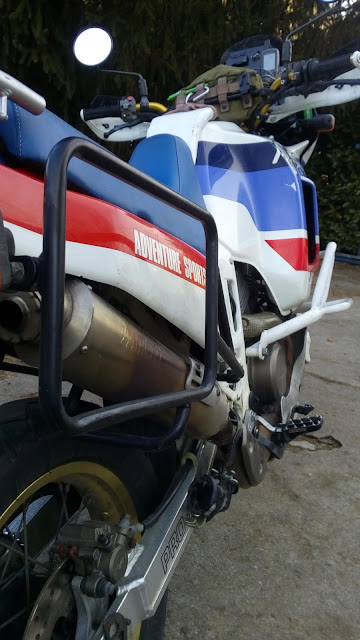A lot of XRV owners replace the suspensions of the bike with USD forks and fency gold colored rear shocks. This is a very expensive solution and I don't like it.
Boano sells this kit for the XRV series. Around 2000 €.
It is for sure a good improvement, but it is really to expensive in my opinion.
Moreover this kit leads to a problem: as these replacement forks are more stiff, the bearing of the front wheel are more stressed and they need to be changed a lot more often. On forums a lot of people with these forks say that they always have spare wheel bearings with them even for small raids in Marocco.
I've never changed any of these bearings in more than 26000 km.
The original forks of the XRV 650 are very nice in my opinion, because they allow the user to tune them properly and, as they are not so stiff, it is easier to ride the bike.
Here you can find everything you need to know about the XRV 650 suspensions:
http://www.xrv650.eu/do-it-yourself/modifications/suspension-upgrading
In the front forks I have fit Wirth springs and I'm fine with them.
The sag with me on the bike was to high, so I've placed some sheems between caps and springs in order to increase the preload.
Fork caps and shems increasing the preload (Total thickness is 7,5 mm).
I'm very happy with this set up of the bike.
The fork oil should be changed every 20000 km or less if you are riding a lot off road. I've changed mine after 26000 km with a lot offroad.
Fork oil after 26000 km, it looks like engine oil.
You don't realize that the forks change the behaviour because it is a slow process. When you renew them, you really feel the difference.
The rear shock of the XRV 650 is the best compromise between performance and longevity: don't change it if you want to use the bike for riding all around the world!
It can be renewed and I really suggest everybody to change the spring, unless you weight 70 kg with the full riding equipment on you. The hyperpro one it is said it is the best one. But as I'm taller and bigger than most of the people, I went for a spring with 140 N/mm spring rate: before the trip to Caucasus I had no time to wait for the spring and to renew the shock, so I changed it with a Hagon one with a 140 N/mm spring rate.
It did its job well despite it had no external tank but in Igoumenitsa, after more than 20000 km, it started leaking oil.
Tune the suspensions of your bike in order to create a better relationship between you and it.
Don't forget to talk to it from time to time!











